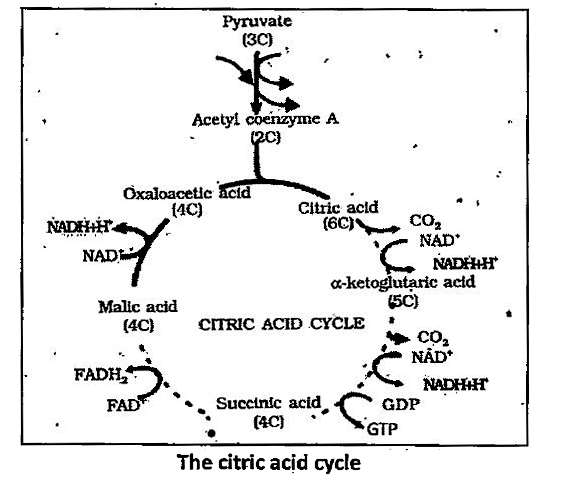Explain the reactions of Kreb's cycle. Solution in Telugu
Video Solution
Text Solution
The reaction sequence of Kreb.s cycle is as below.
1. Condensation : Acetyl co-enzyme A condenses with oxaloacetic acid and results in the formation of citric acid and co-enzyme-A. This condensation reaction is catalysed by the enzyme .citric synthetase.
Oxaloacetic acid + Acetyl CoA Citric acid + Coenzyme A.
2. Dehydration : The enzyme .aconitase. catalyses the removal of one molecule of water from citric acid leading to the formation of cis-aconitic acid.
Citric acid Cis - aconitic acid +
3. Hydration : Addition of one molecule of water is done in the presence of aconitase Cis-aconitic acid forms Isocitric acid.
Cis-aconitic acid isocitric acid.
4. Oxidation - I : Isocitric - acid undergoes dehydrogenation (oxidation) in the presence of .isocitric dehydrogenase. enzyme, leading to the formation of oxalosuccinic acid. In this reaction NAD is reduced to NADH + .
Isocitric acid + NAD + Oxalosuccinic acid
5. Decarboxylation : Oxalosuccinic acid releases one molecule : of in the presence of oxalosuccinic decarboxylase enzyme and forms ketoglutaric acid.
Oxalosuccinic acid -ketoglutaric acid.
6. Oxidation - II : - ketoglutaric acid undergoes oxidation (dehydrogenase) decarboxylation and condensation with one molecule of CoA leading to the formation of succinyl coenzyme A.
- Ketoglutaric acid + NAD + Coenzyme A
Succinyl conenzyme
7. Cleavage : Succinyl coenzyme A splits into succinic acid and coenzyme A by the enzyme activity of succinic acid thiokinase. Energy released in this reaction is utilised to form ATP from ADP and inorganic phosphate.
Succinyl coenzyme A + ADP + Pi
8. Oxidation II : Succinic acid then undergoes oxidation and forms Fumeric acid. Instead of , FAD serves as hydrogen acceptor in this reaction. Therefore FAD is reduced to FADH,. The enzyme which catalyses this reaction is known as succinic dehydrogenase.
Succinic acid Fumeric acid
9 Hydration: The enzyme Fumerase mediates the addition of one water molecule to fumeric aicd leads to the formation of malic aicd.
Fumeric acid Malic acid.
10. Oxidation IV : In the presence of Malic dehydrogenase, Malic acid releases two hydrogen atoms and gives rise to oxaloacetic .acid. In this step acts as hydrogen acceptor and is y converted into NADH
, Malic acid + NAD + Oxaloacetic acid

|
Topper's Solved these Questions
Similar Questions
Define and explain water potential.
View SolutionDescribe the structure of the heart of a man. Draw a neat labelled diagram of it.
View SolutionGive an account of glycolysis, Where does it occur ? What are the end products? Trace the fate of these products in both aerobic, and anaerobic respiration.
View SolutionIn Kreb's cycle
View SolutionKreb's cycle
View SolutionExplain the Kreb's cycle with reaction.
View SolutionThe first reaction of Kreb's cycle includes:
View SolutionExplain the anabolic nature of Kreb's cycle.
View SolutionLink Reaction|Introduction to Kreb's Cycle
View SolutionKreb's Cycle
View SolutionExplain the Kreb's cycle with reaction.
View SolutionAnswer in detail: Explain glycolysis and Kreb's cycle in detail.
View SolutionIn Kreb's cycle
View SolutionKreb's cycle
View SolutionWhat is Kreb's cycle? Explain briefly.
View SolutionKreb's Cycle
View Solution
